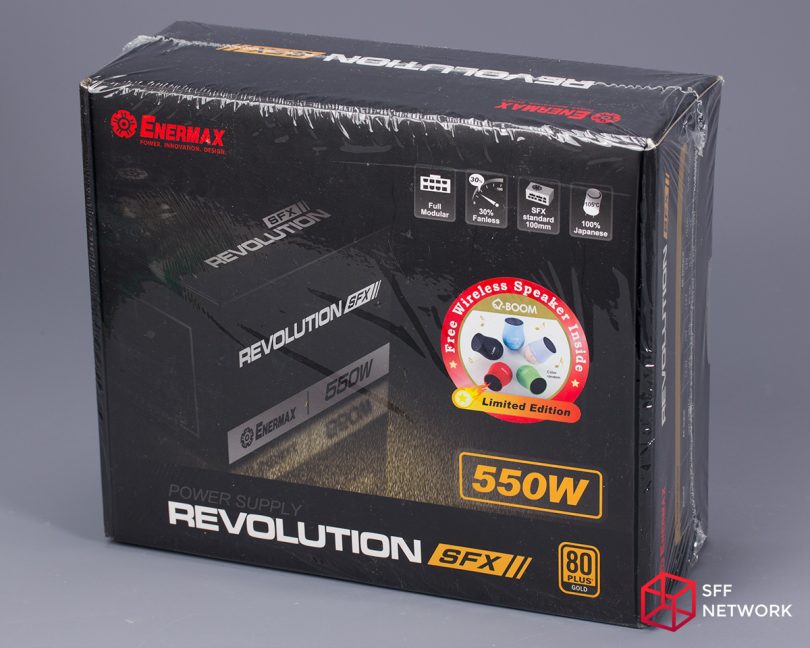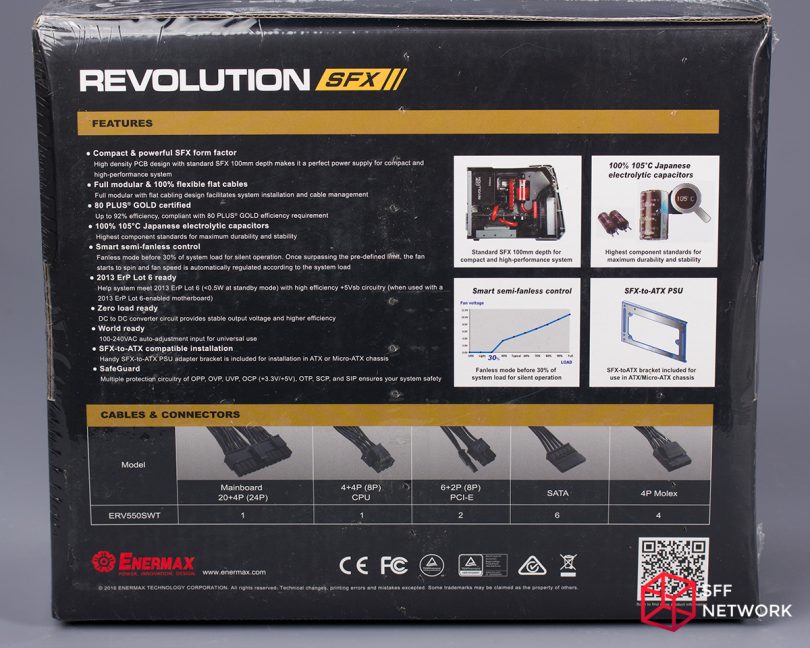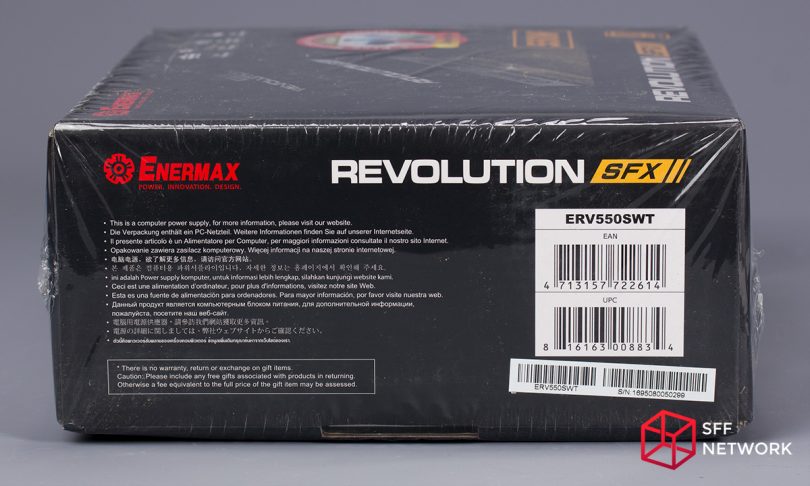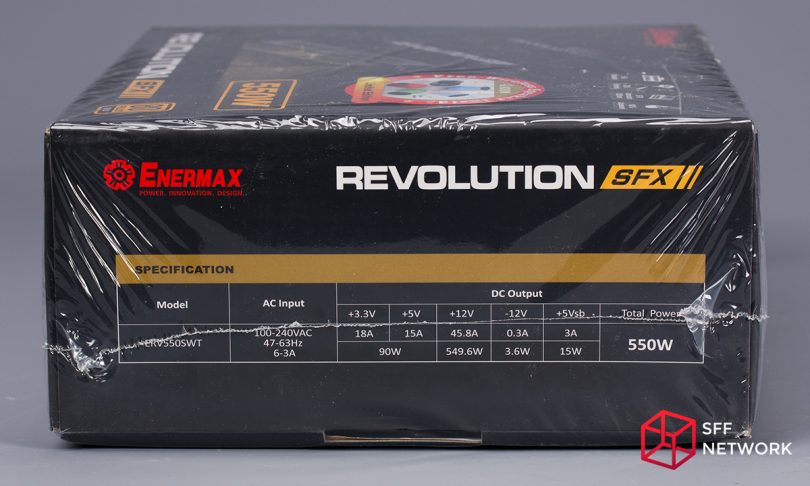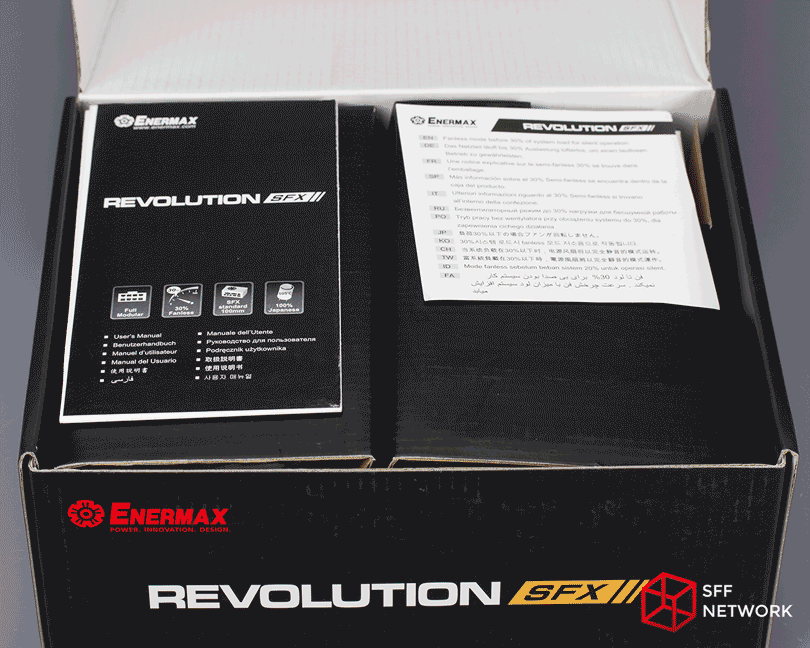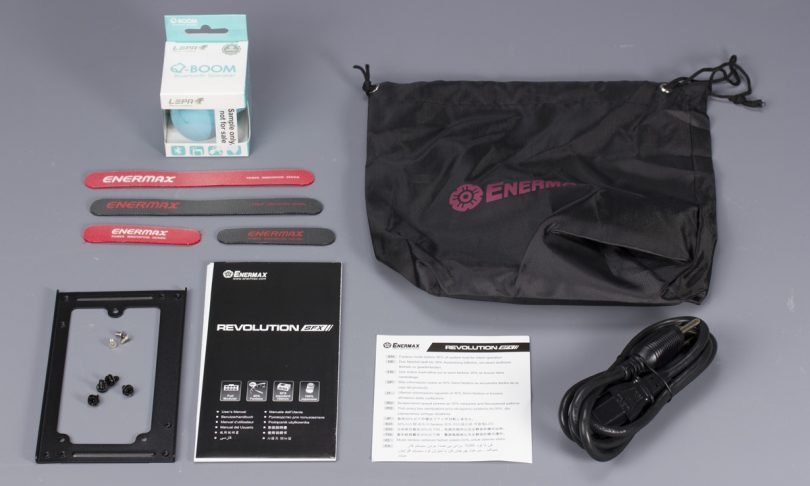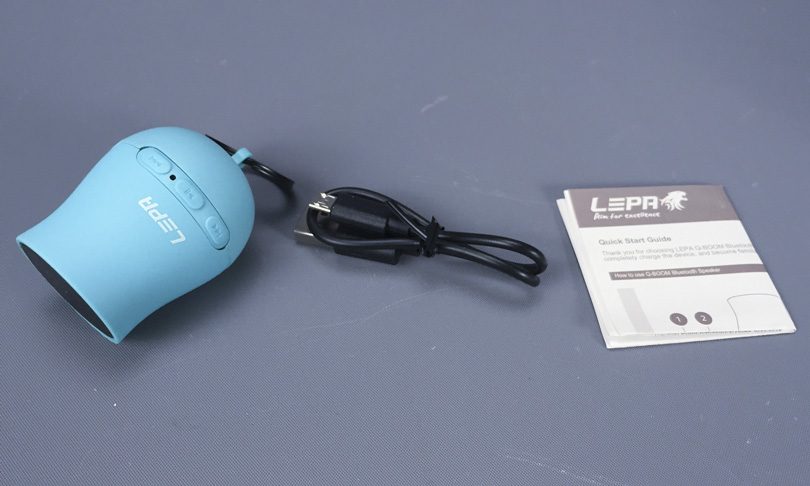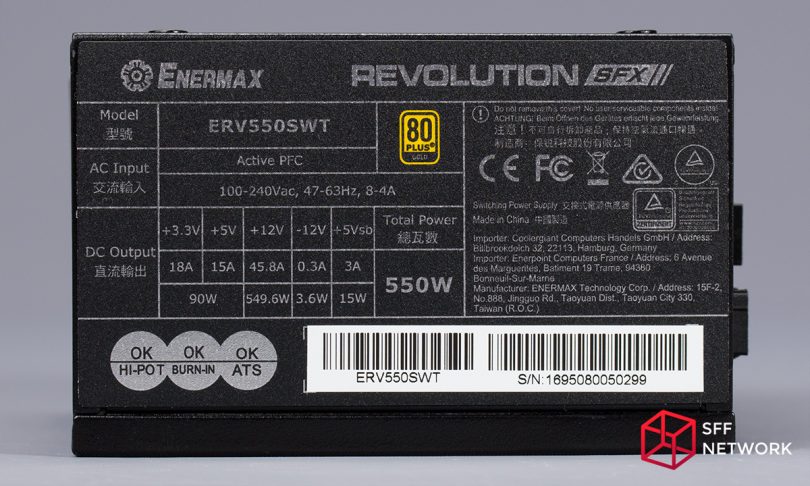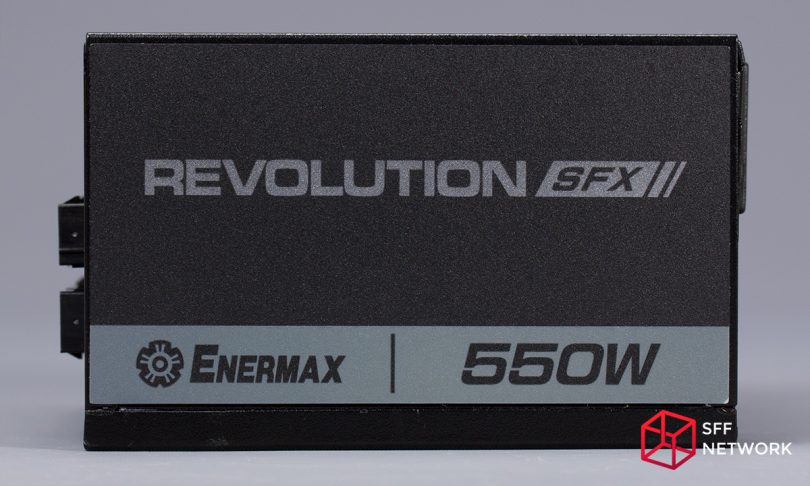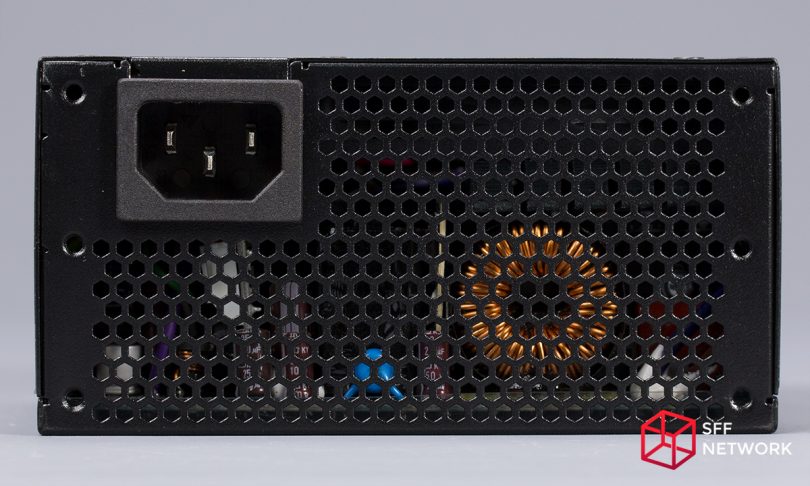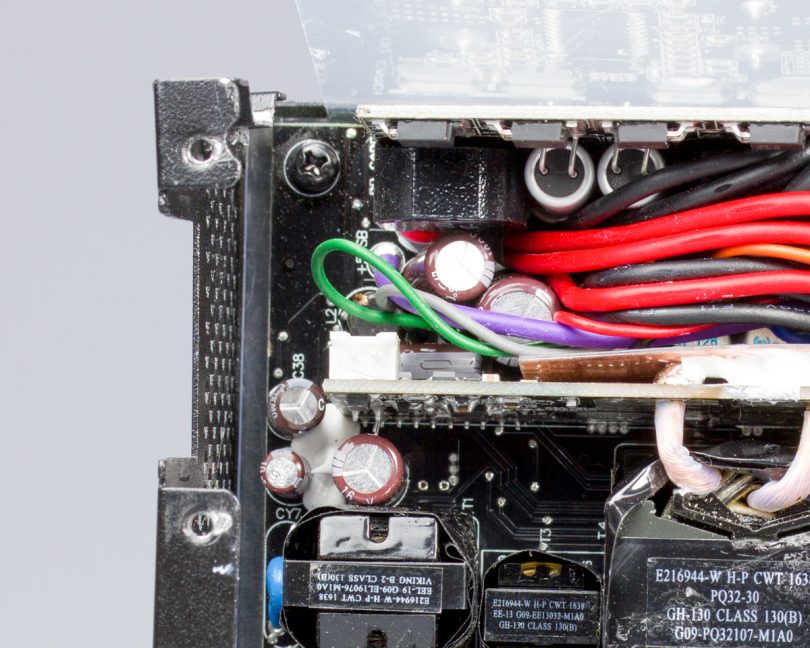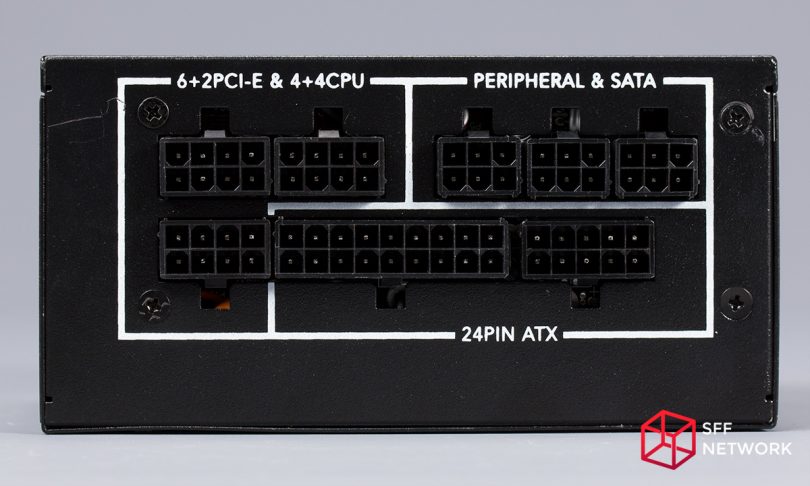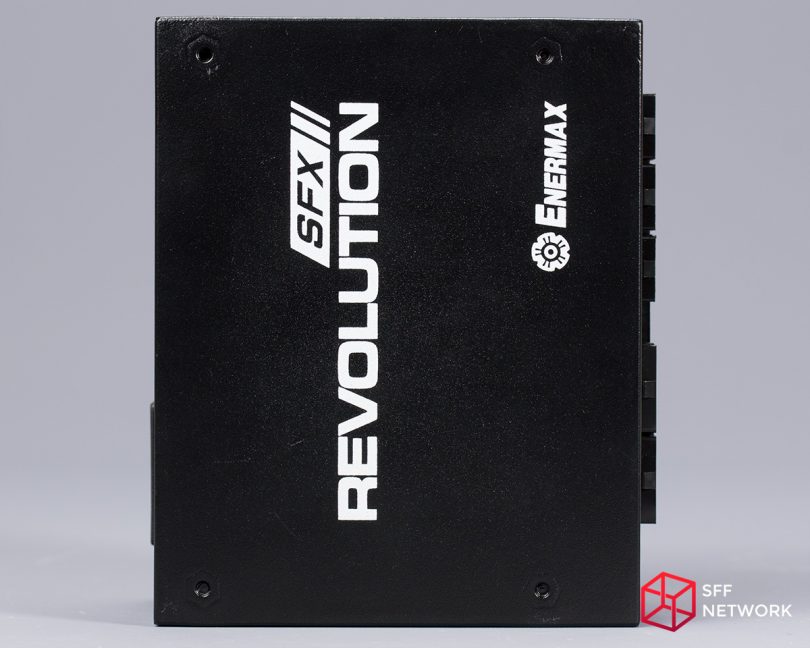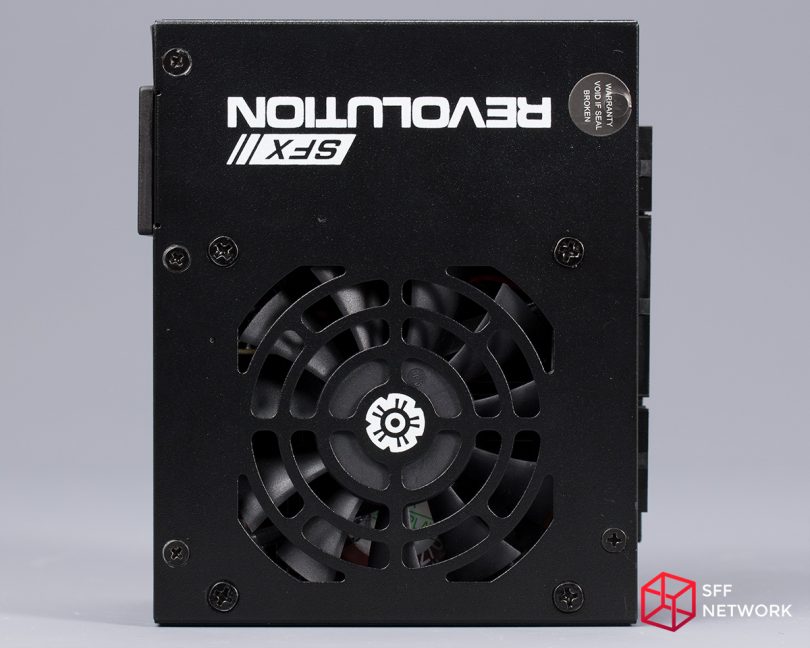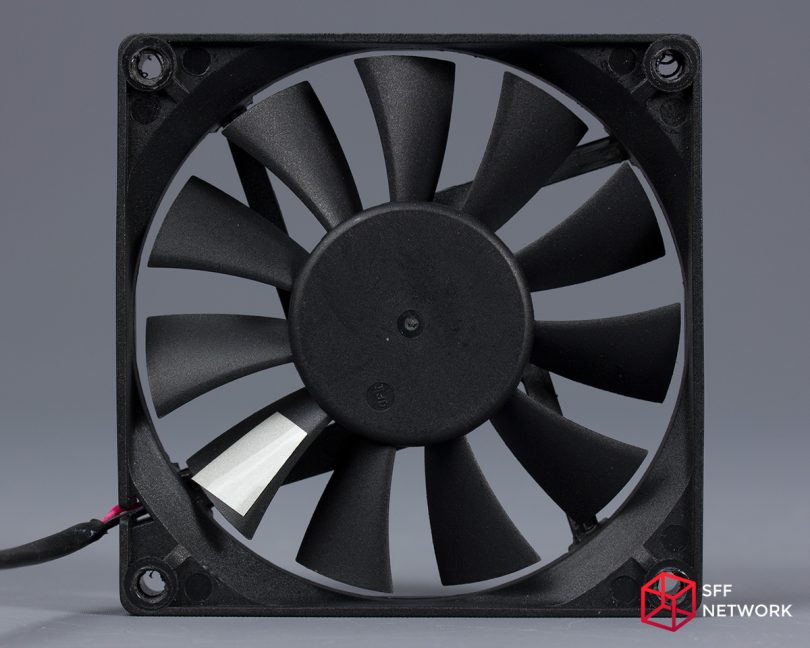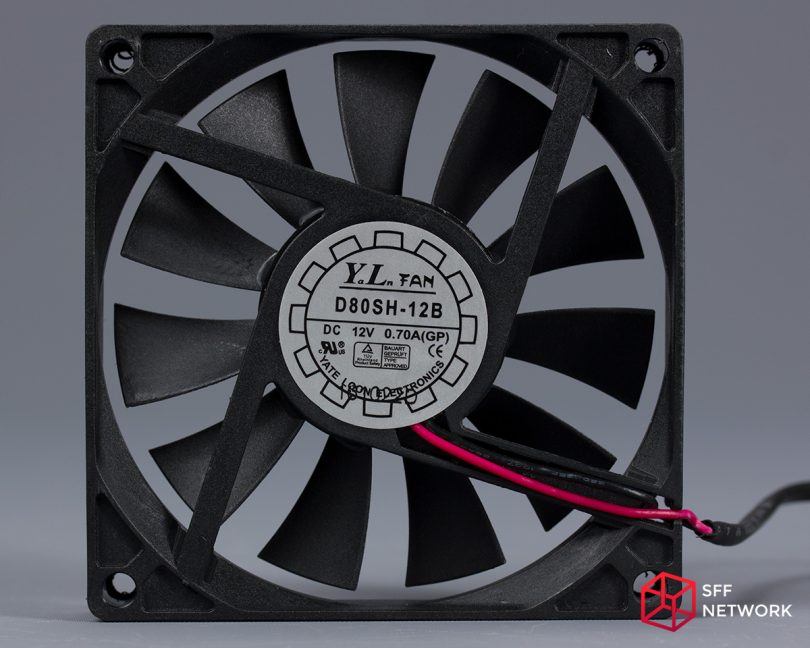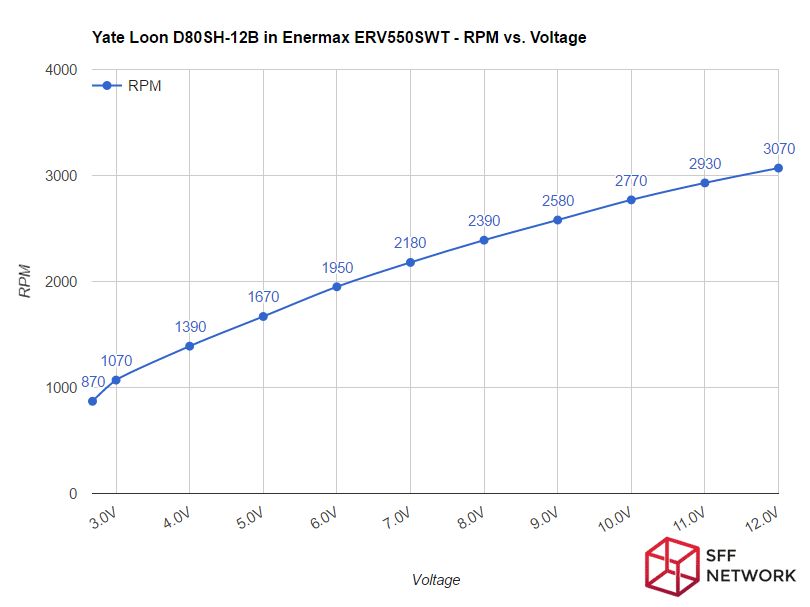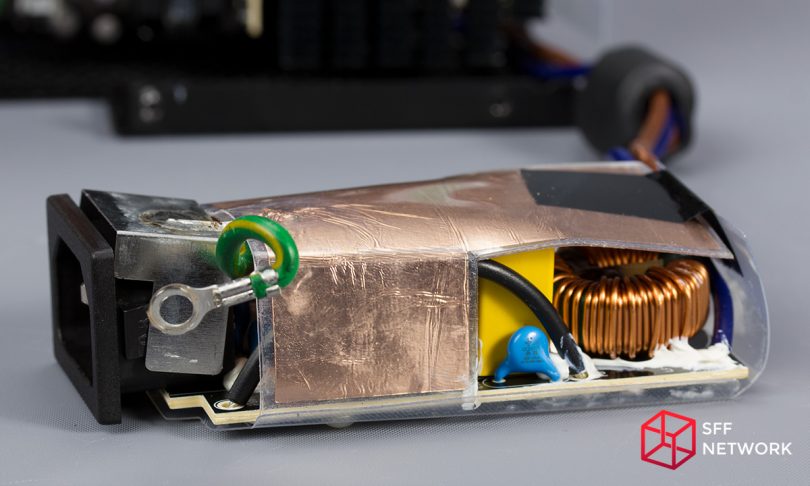The SFX power supply market must be growing, because it seems like every few months now there are companies announcing new PSUs aimed at SFF enthusiasts. It was late last year that Enermax announced their Revolution SFX series, and today we’re now looking at the Revolution SFX 550W. While Enermax is no stranger to power supplies – and has even sold SFX units in the past – this is their first one aimed at the compact gaming rigs that have become significantly more prevalent nowadays.
At a high level, the Revolution SFX 550W features fully modular cables, Gold-rated efficiency, all-Japanese capacitors, and is a 550W unit (as you might have guessed). There is also a 650W version that is part of the same series. But there’s a lot more going on here, and the underlying performance and noise characteristics are to be seen.
Ready to dive in?
Table of Contents
A disclaimer first before we get started: SFF Network does not currently possess the expertise or equipment to fully test the electrical performance of PC power supplies, and as such, this article should not serve as the sole data point in determining whether to purchase this product. We’ll be able to contextualize the utility and experience of using this unit with others in the market place, but we’d suggest having our own review supplement those by others who have the hardware and capability to do more thorough analysis of electrical performance, especially at higher wattages.
The Box
As always, we start with the packaging that the unit arrived in. For the Revolution SFX 550W, we find that the front of the box is a straightforward affair, with the model series and wattage listed, and a few basic marketing points – as well as a a hint at a freebie! Very exciting.
The back of the box expands on those aforementioned marketing points:
- Standard 100mm deep SFX form factor
- Fully modular and flat cables
- 80 PLUS Gold efficiency
- All Japanese electrolytic capacitors with 105°C ratings
- Smart semi-fanless operation
- 2013 ErP Lot 6 capable for low standby power draw
- DC-DC design for today’s 12V heavy systems
- Wide input voltage for international compatibility
- ATX adapter bracket
- Multiple safety protections
Demonstrating that Enermax’s marketing department understands product synergy, one of the pictures here shows the PSU in a fully loaded SteelWing case, which we recently reviewed. The chart for the semi-fanless functionality could use some work, however; it plots PSU load against fan voltage, but without knowing the voltage/RPM curve of the fan it’s a fairly meaningless bit of information on its own.
Moving along, we see that below the marketing material, there’s a chart with the connector list.
…And just in case you didn’t realize it from looking at the rest of the box, there’s an amusing disclaimer on the left side that says “This is a computer power supply”. Interestingly, this “warning” is repeated in quite a few languages, although all the marketing copy on the rest of the exterior is only in English.
While it’s marketed as the Revolution SFX 550W, the UPC and SN stickers show this PSU’s actual model number: ERV550SWT.
Anyhoo, over on the right side of the box is the AC input specs, as well as the output table. As mentioned in the marketing, this is a DC-DC design, so the full 550W rated wattage is available on the 12V rail alone.
Finally, as we crack the box open, we can see that while the Revolution SFX 550W ships in a fairly large box, there is little wasted space.
Accessories
Once spread out, it’s pretty easy to see what was taking up so much space! There’s the power cord, a flyer (warning the user that this is a semi-fanless power supply), a user manual, an ATX adapter bracket in black, 3 x countersunk screws (for attaching the PSU to the adapter), 4 x regular screws (for either mounting the PSU directly or for mounting the adapter to the case), and two short and two long velcro straps for cable management.
The velcro straps are a very nice touch, and now I wish more SFF power supplies came with them. I’m constantly tweaking my system, so having something reuseable would come in handy in lieu of wasting zip ties. I also like how they’re branded, but without being obnoxious, as well as how they use Enermax’s signature colors, and come in two different lengths. All-in-all, they’re quite nice and handy.
Also included is a drawstring pouch for storing the unused cables. While not as luxurious as the (admittedly silly) velvet bag Corsair sometimes bundles with their high-end PSUs, it’s a big step up from any other SFX or SFX-L power supply I’ve reviewed thus far, of which I’ve only seen a really flimsy bag from Lian Li, and either nothing or (if I’m lucky!) just a cardboard box from SilverStone.
Ok, so moving right on along…
…Just kidding! I’m sure you all are wondering what’s up with that little box in the corner.
So apparently as a limited-time offer, these Enermax Revolution SFX units come with a Lepa Q-Boom BTS03 Bluetooth speaker in a random color! Why? I don’t know.
The contents of the box are pretty simple – just the speaker, USB cable, and quick start guide.
As appropriate for a SFX power supply, this is very much a SFF Bluetooth speaker.
Cables

Cable lengths are as follows, from top to bottom:
- 4x 4-pin Peripheral (200mm / 150mm / 150mm / 150mm)
- 3x SATA (200mm / 150mm / 150mm)
- 3x SATA (200mm / 150mm / 150mm)
- 4+4-pin CPU (400mm)
- 24-pin motherboard (300mm)
- 1x 6+2-pin PCIe (400mm)
- 1x 6+2-pin PCIe (400mm)
(The first number is from the PSU-side to the first connector, and the second number is from the first connector to the second, and so forth.)
It would appear that Enermax has been paying attention to the competition, with cable lengths very comparable to other recent SFX/SFX-L units. This is something I’m very pleased to see, though, because while there always be some SFF builds where the stock cables are too short or too long, I think the convention of 300mm for the 24-pin and 400mm for the PCIe/CPU is a good compromise that provides a functional length for most.
Wire gauge is suitable, and the wires are okay in regards to flexibility. They’re not nearly as good as what SilverStone ships with their modern SFF power supplies, but not as bad as the stock cables on the Corsair SF600.
I would have liked to see a 4-pin to floppy power adapter bundled for hooking up fan controllers and the like, but otherwise the connector selection is good for the wattage, as well.
A pleasant surprise is the motherboard power connector, which is not of the typical 20+4 type, but rather a solid 24-pin block. The motherboard ATX power connector is unwieldy enough as it is, and having to also line up the two separate pieces of a 20+4-pin connector just makes plugging it in that much more annoying. To add insult to injury, the ATX12V 2.0 revision (that added the specification for the 24-pin connector) came out a full 14 years ago, in February of 2003! Consumer motherboards have not used the 20-pin connector in almost as long, so why PSU manufacturers keep accommodating that archaic standard simply baffles me.
In any case, they do, so I had given up hope that things would ever change. But now that Enermax has shown the way, I’ll be looking for it on all future power supplies that come my way.
Pinout
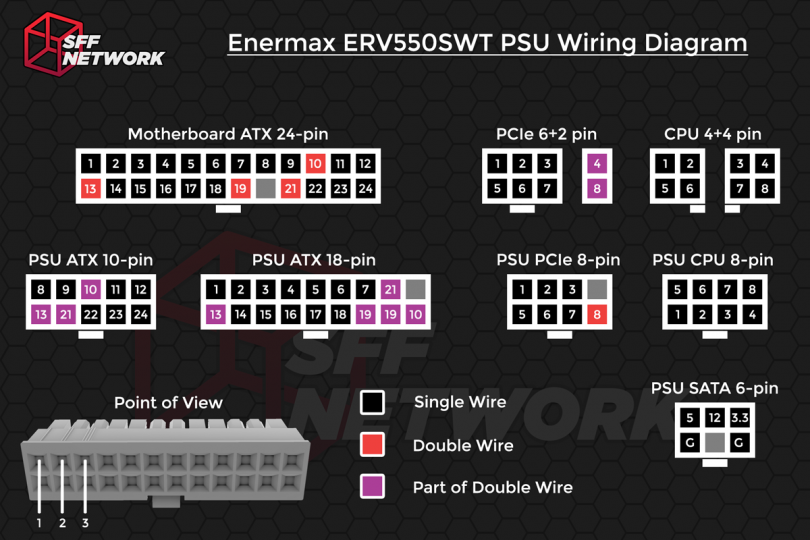
Sadly for the cable sleevers out there, the Enermax ERV550SWT has several doubled wires. It appears to be compatible with at least some of the Corsair SF450/SF600 cables, but I would highly recommend checking very carefully before attempting to use any of those Corsair cables on this power supply.
The Power Supply
The Enermax Revolution SFX 550W is a sharp looking unit, with a lightly-textured black paint job and a matching label with grey text that blends in.
The modular connectors stick out about 4.0mm past the housing.
The unit itself weighs 0.908kg.
The main label, serial number, and QC stickers are all condensed onto one face of the PSU. No surprises here, and I like that the label has a slight texture to it to match the paint.
On the other side is a similarly textured label with just the company name, PSU family name, and wattage. The font makes the 550W look like 660W, though, at least to my eyes.
The back of the Revolution SFX 550W is very extensively ventilated, though part of what makes that possible is the lack of a power switch. While a switch can be convenient, many of the SFF cases coming out these days have the PSU mounted internally where the switch wouldn’t be accessible anyway, so I don’t consider the lack of one to be a big deal. Still, worth nothing.
Rather than just the corners, the entire rear edge of the PCB is inset from the rear of the housing. There is a plastic shield, but the PCB isn’t inset that far and the shield could get bent out of the way, so take care if using non-standard screws.
The modular connectors are clearly marked, and the cutouts for the clips are not too big.
While I’ve been very impressed with what I’ve seen from Enermax so far, here I’m a bit disappointed. The cooling fan is only an 80mm, which would have been acceptable 2-3 years ago, but the Corsair SF450 and SF600 feature a 92mm fan, as well as the upcoming SilverStone SX500-G and SX650-G. That the fan is offset all the way to one side suggests that the inside must be pretty cramped as well. Also, the fan vent is just stamped from the housing instead of using a less restrictive wire grill. This is generally done as a compromise towards cost in expense of performance.
But there’s still hope. With a robust fan controller implementation to keep the fan off (or at least quiet) under low load conditions, the smaller fan may not be all that disadvantaged.
Testing
As mentioned at the beginning of the review, we currently lack the expertise and equipment to properly evaluate the electrical performance of power supplies to a complete extent, so the following data is more to demonstrate that the Enermax Revolution SFX 550W is capable of powering the test system with no issues.
Test hardware:
| CPU | Intel Core i7-5930K |
| Motherboard | Asus X99-M WS |
| Cooling | Noctua NH-C14S with black NF-A14 PWM |
| PSU | Enermax EVR550SWT |
| RAM | Crucial Ballistix Sport 16GB (2x8GB) DDR4 2400 |
| Video Card | 2x MSI Radeon R9 280X Gaming |
| Storage | Samsung 840 EVO 500GB |
| Case | Lian Li PC-6X tray |
| OS | Windows 10 64-bit |
Test equipment:
- Brand Electronics 4-1850 power meter, used to measure the AC draw of the system.
- Reed AT-6 non-contact tachometer, used to measure the fan RPM.
- Pax Instruments T400 temperature datalogger with Omega thermocouples, used to measure ambient, intake, and exhaust temps.
- Fluke 83 III multimeter to measure voltage.
Methodology:
Each test is run for 10 minutes, and then readings are taken before moving on to the next test. Both video cards were installed for all tests, but on the fourth test CrossFire was disabled and FurMark was run on a single GPU. For the fifth and last test, CrossFire was enabled and FurMark was run on both cards.
Test Results:
| Wattage (AC) | Ambient Temp | Intake Temp | Intake Delta | Exhaust Temp | Exhaust Delta | Fan RPM | 12V | Test |
| 73W | 20.6°C | 26.3°C | 5.7°C | 23.6°C | 3.0°C | 0 RPM | 12.05V | Idle |
| 130W | 20.6°C | 25.3°C | 4.7°C | 33.0°C | 12.4°C | 0-800 RPM* | 12.04V | 2 threads of Prime95 Blend |
| 190W | 20.8°C | 25.0°C | 4.8°C | 35.0°C | 14.2°C | 0-1100 RPM** | 12.03V | 10 threads Prime95 Blend |
| 440W | 20.7° | 22.4°C | 1.7°C | 29.8°C | 9.1°C | 2120 RPM | 12.03V | 10 threads Prime95 Blend, FurMark 1x 280X 720p no AA |
| 600W | 20.9° | 22.9°C | 2.0°C | 30.2°C | 9.3°C | 3030 RPM | 12.04V | 10 threads Prime95 Blend, FurMark 2x 280X 1080p 4x AA |
*Fan started cycling between 1-2 seconds on and 1-2 seconds off about 8 minutes into the test.
**Fan cycling continued through whole test though by the end the fan was staying on for 3-4 seconds instead
The Enermax Revolution SFX 550W powered my test setup with no issues.
Fan
As mentioned earlier, the cooling for the Revolution SFX 550W is provided by a slim 80mm fan. As usual, the silver rectangle on the bottom blade is a piece of reflector tape for the non-contact tachometer.
The fan is a Yate Loon D80SH-12B, and for once there are manufacturer specs available, though the details are a bit lacking. From the label we know it is a 12V 0.70A fan, and from the product page we also learn that it has sleeve bearings, a rated speed of 3000 RPM, 29.0 CFM, and 32dB of noise.
As per the rating, the Yate Loon D80SH-12B tops out at just a bit over 3000 RPM. The fan starts at 2.68V at 870 RPM, but from 2.64V up to when it starts, the fan makes some spurious buzzing/crackling noises.
Fan Controller
The marketing on the box touted a “Smart semi-fanless control” and a “Fanless mode before 30% of system load for silent operation”, so that means a load-based controller that keeps the fan off under that 30% load mark, right? Unfortunately, no.
The fan controller on the Enermax Revolution SFX 550W is actually just a simpler thermistor-based design. The fan header spikes to 12V when the PSU powers on (so users know the fan isn’t defective due to the semi-fanless functionality), but then it drops to around 1.25V and the fan stops. From there, as the inside of the unit heats up, the thermistor heats up and the fan voltage rises accordingly, until it meets the fan’s start threshold of about 2.68V (also transitioning through those annoying noises right before spinup), and the fan turns on.
So far, this is the same behavior as the SilverStone SX600-G. The fan will stay off at first, but even while idling, the internals will eventually warm up enough for the fan to start. Unlike that SilverStone, though, the Enermax’s fan will turn back off on its own. Which would be a big improvement, except that this unit has no hysteresis and a sensitive thermistor that seems to be in the direct airflow path of the fan.
Consequently, what happens is that the residual heat inside the PSU warms the thermistor back up within a few seconds, causing the fan to spin up for 1-2 seconds (and thus cooling off the thermistor), causing the fan to shut off. With the fan off, the thermistor warms up once again, and the process then repeats until either the computer is turned off, or the load (and thus heat) increases until the fan simply stays on continuously.
To be fair, I encountered this behavior with the PSU in open air and the fan facing up. This particular configuration may be more susceptible to this hysteresis issue, and this is also only a sample size of one. When I asked Enermax about this, they confirmed that hysteresis didn’t make the cut during product development due to the extra cost and lack of space, but they also noted that they had not run into this exact issue during their verification process.
Noise
At least in my experience with my unit, I’ve not been very impressed with the noise levels. The noise of the fan cycling on and off is annoying, mostly due to the spurious noises the fan makes as the header voltage rises and the fan turns on. This woudn’t be so bad if the fan turned on and stayed on like the SX600-G, but instead the fans turns on and off, making those strange noises every 4-6 seconds for hours on end. Again, to be fair though, with the PSU inside a case and in a noisier environment, it may not be noticeable at all.
At high loads the fan is quite noticeable, though, with the fan reaching its full speed of around 3000 RPM in Test 5 at full load. This is the problem with using a slim 80mm fan in a high-wattage SFX PSU with a crowded interior – in order to generate the airflow and static pressure necessary, it has to spin at much higher speeds than would be ideal. The consequence is a lot of noise.
Protections
Using a blowdryer, I was able to verify that Over Temp Protection works, and the PSU shut off as expected. The system would not power back up right away, but after unplugging and replugging the power cord, the system then was able to turn on.
According to Enermax’s product specs, this unit also features Over Power, Over Voltage, Under Voltage, Short Circuit, and Surge & Inrush protections. Quite a comprehensive list.
Internals

As I suspected the inside of the unit is pretty cramped, though it’s actually not as bad as I thought it would be. The general layout is similar to the Enhance platform that the SilverStone SX600-G uses, with the large offset of the 80mm fan necessary because the AC inlet and filtering sits to the side of the fan. The OEM for the Enermax though is CWT (Channel Well Technology).
(Here’s the AC section, if you were curious!)
Conclusion
If the Enermax Revolution SFX 550W had been released 2-3 years ago, I feel that it would have been competitive against the only other high-wattage SFX unit available – the SilverStone SX600-G. They are both of similar wattages, efficiency, noise levels, and both have somewhat flawed semi-fanless implementations.
The landscape for SFX and SFX-L looks much different today than it did even two years ago, though. The packaging and accessories Enermax used here definitely stand out from the crowd, but the unit itself falls short in comparison to today’s competition, namely the Corsair SF600 (which we reviewed here). At 600W, the Corsair falls right in between this Enermax and its 650W brother, but for most SFF builders the 50W difference either way won’t matter much.
The Revolution SFX 550W is currently listed at its MSRP of $109.99 on Amazon, while the SF600 is $116. So for price of a nice latte, you get a 92mm fan, much better (but not perfect in my experience) semi-fanless behavior, a smooth-sounding 92mm fan with rifle bearings, and a slightly longer 7-year warranty instead of 5 years on the Enermax. You would give up the ATX adapter bracket, velcro straps, and mini Bluetooth speaker (though that’s a limited time offer anway), but those are just niceties that are not relevant to the actual performance and operation of the power supply.
Overall, I really wanted to like the Enermax Revolution SFX 550W. The presentation is well-done and the bundled accessories are more comprehensive than anything else I’ve reviewed thus far (though the BT speaker is a weird addition, if not a neat one)… but the fan controller and noise levels lag behind the current state of the art of SFX power supplies.
Even so, it’s great to see more companies jumping on the SFF PSU bandwagon, and Enermax has certainly proven their competence and capacity to build solid all-around units, replete with generous and thoughtful accessories. As such, I do hope to see future products in Enermax’s SFX line that can address these issues and make their SFX offerings more compelling to more SFF enthusiasts.
[mks_separator style=”blank” height=”2″]
Thoughts? Share them in the forum here.
[mks_separator style=”blank” height=”2″]
Review sample provided by Enermax.
Here at SmallFormFactor.net we give manufacturers the ability to be part of the community. We offer a right to reply to hardware reviews. If a manufacturer responds, their comments will be posted here.
Feb 28 edit: The warranty is actually 5-years, not 3-years and the MSRP is $109.99. The article has been updated accordingly.

